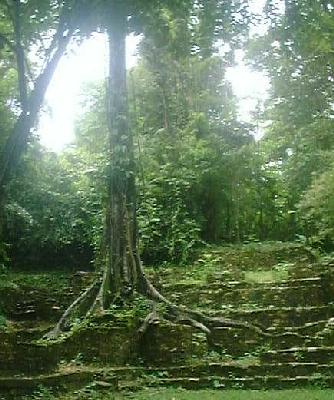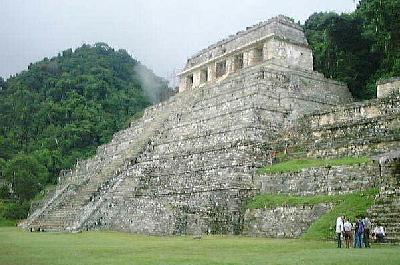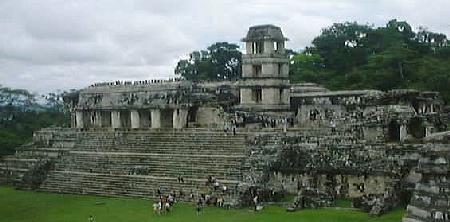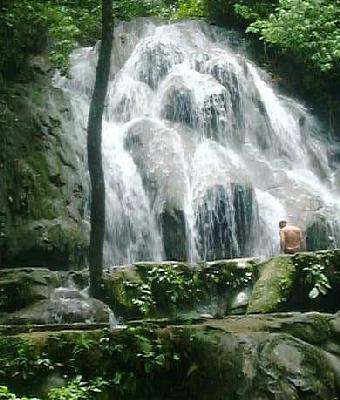
Palenque

The jungle has reclaimed many of the ruins (spot the steps)
Friday 3rd September 1999
Palenque (Palisade) is the Spanish name for this beautiful Mayan town. No-one is certain what the Mayan name was, as the Mayan chronicles make no mention of it, save for a cryptic reference to Nachan or Chocan (City of Snakes or Sculptured Snake), which may refer to Palenque. Pottery fragments found at the site indicate that it was first occupied over 1500 years ago, and the city flourished from around 600 to around 800 AD. It first became an important city under the leadership of Pakal, who ruled from 615 to 683 AD. Pakal is represented in the Mayan script by the signs for sun and shield.
Pakal's reign saw the glory days of Palenque, and many plazas and buildings were constructed during his reign. Most prominent of all was the Temple of the Inscriptions; the inscriptions which gave this building its name show a date of 692 AD and tell the history of Palenque and the temple. Unfortunately, this building was closed for repair work when we were there, so we were unable to visit the crypt, which is the tomb of Pakal, apparently making this temple unique amongst Mayan cities in that it served as a mausoleum for the ruler, Lord Pakal. Pakal's rule was predicted thousands of years before hand, and would be celebrated for a long time afterwards, according to texts found at Palenque.

Temple of the Inscriptions, Palenque
The Mayan rulers of various city states justified their rule on the basis of heritage, and to them genealogy was very important; indeed, some scholars believe that some of the Mayan genealogies may be amongst the oldest in the world, with continuous lineages dating from today all the way back to perhaps 1000 BC. Certainly some of the people alive in the Mayab (the Mayan lands) today can trace their ancestry back to pre-Hispanic times, and thence even further back, and the ruling classes in the time of the classical Maya were sometimes known as "the men who had fathers and mothers", i.e. those with good family histories.
Pakal was succeeded by his son, Chan-Balum, represented in hieroglyphics by the jaguar and the serpent. He followed in his father's footsteps, expanding Palenque politically and economically and further developed art and architecture. He had the Temple of the Inscriptions completed, and ordered the construction of the temples around the Plaza of the Sun. By this time Palenque had influenced the architecture of places as far away as Tikal in Guatemala.
Soon after Chan-Balum died, Palenque went into sudden decline, for reasons which have not been determined, perhaps environmental disaster, civil unrest or invasion. After the 10th century, Palenque was for the most part abandoned. The heaviest rain in Mexico, which this area of Chiapas receives, means that the site was rapidly reclaimed by the jungle and remained hidden until it was rediscovered in the 18th century. Hernan Cortes the conquistador apparently passed within 40 kilometres of the site without knowing it, but it was not until 1773 that a group of Mayan hunters told Father Ordonez y Aguilar that the jungle hid stone palaces; the priest organised an expedition and wrote a book about his findings. A later expedition in 1787 led to a report being stored in the Guatemalan archives to be subsequently translated by a British resident of Guatemala and published in England in 1822, sparking a mini-boom in explorers searching for the ruins. One of these explorers, Count de Waldeck, lived on top of one of the pyramids at Palenque for two years and then wrote a book, replete with faked drawings which made Palenque look like the classical Mediterranean civilisations, provoking greater interest in Europe, where Palenque was envisioned as a lost Atlantis or an extension of ancient Egypt.
Opposite the Temple of the Inscriptions is El Palacio, which may have been unique among Mayan buildings due to its tower, which was reconstructed in 1955. Researchers believe that the Palace may have been built to allow royalty and the priest class to observe the sun falling onto the Temple of the Inscriptions during the winter solstice.

El Palacio with tower, Palenque
The Group of the Cross consists of four buildings located around a central plaza across the stream from the Temple of the Inscriptions. These were built by Pakal's son Chan-Balum. The Temple of the Sun has the best preserved roof in Palenque and has inscriptions dating from 642 AD showing offerings to Pakal. The Temple of the Cross is the largest of this group of buildings and also contains narrative stones, while the semi-dilapidated Temple of the Foliated Cross reveals the construction techniques used by the Mayan architects.

Beautiful jungle waterfall, the Bath of the Queen
Further downstream there are more ruins of what were probably residential buildings; these are of interest mostly because of their fabulous setting, surrounded by jungle wilderness and a couple of beautiful waterfalls.
We made the day trip to Palenque from Villahermosa, which is probably the most disappointing place on our travels so far. The name means Beautiful Town, but it's basically a hole; Lonely Planet suggests that the oil boom apparently experienced by the town has made it a beautiful place, but we found it to be an expensive, unfriendly dump. The hotel it recommended (the San Francisco) had giant cockroaches, a sullen receptionist, expensive prices, mosquitoes in the hallway, and staff who went through our bags while we were away (apparently deciding that my laptop was not worth stealing). In general, we've found Mexicans to be very friendly, but that seems to have passed Villahermosans by completely. We won't be coming back here, that's for sure.

Mayan hieroglyphs from Palenque
Mexico index | Travel index | Family history | Romany | Main index